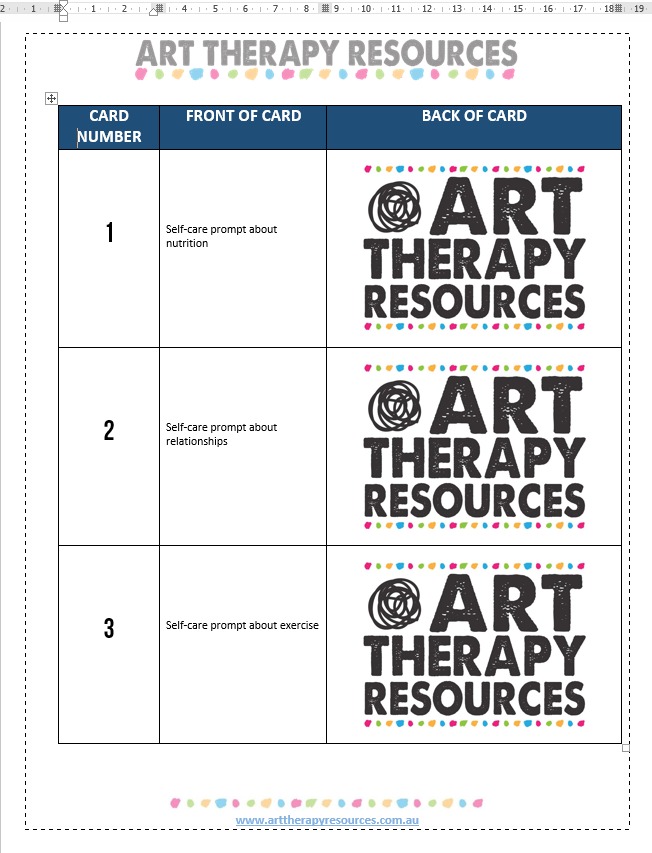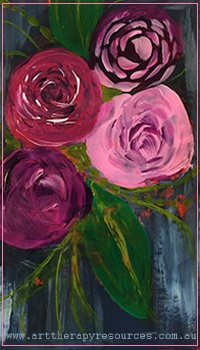THIS POST INCLUDES:
1. What are art index cards
2. Create art index card content
3. Design art index cards
4. Printing art index cards
5. Free Download Index Card Outline Template
WHAT ARE ART INDEX CARDS
Index cards are a creative tool that you can use in a therapy setting to help encourage discussion and creative prompts for reflection.
They are a small art card that the client can use either in session or as homework due to their small size.
Aside from an in therapy tool, therapists can also create index card packs to sell as an additional income stream.
You can use index cards in a variety of ways including a simple way to print daily quotes through to more complex art therapy exercise prompts.
Index cards can be used a passive tool where the client uses a prompt included on the card, or alternatively, index cards can be more active where the client uses the card itself to create their own artwork.
Index cards are useful in group therapy situations where they can be used as a warm-up exercise or as a way for attendees to get to know each other.
Index cards can introduce an element of spontaneity into therapy when selecting a random index card from a pack. This participation can encourage a client to become interested in their own therapy through curiosity in the card they have selected.
Index cards are a useful way to introduce clients to metaphors and images that may connect with their own emotional experiences.
For clients who are non-verbal, using index cards represents an alternative way of communication between client and therapist.
Index cards provide therapists with the opportunity to use an alternative form of learning and communication to clients who are not responding to more traditional exercises and techniques. Through their visual and tactile properties, index cards can be beneficial for those clients who are less interested in relying on words through verbal discussions.
CREATE ART INDEX CARD CONTENT
Before you start to create your index cards, you will want to consider the content that you will include on each card. The content style will depend on the purpose for the card pack.
Some factors to consider for your card pack include:
- Will your cards contain mostly text?
- Will your cards contain mostly graphics?
- Will your card pack be focused around a theme? eg anxiety, grief, relationships etc
- What age group will your index cards be designed for?
- Will your cards be interactive or passive? Will they require a space for a client response on the card?
- How many cards do you want to include in your index card pack?
Using the above questions, you can start to create your content outline for your cards.
There are a number of different options to include on the front and back of your cards including:
- Front and back both text-based
- Front text-based, back image
- Front and back both image
- Front image, back text-based
To create your index card content outline, you can use Microsoft Word, Evernote, or just plain paper and pencil.
If you use Word or Evernote, you can set up your document to contain 3 columns;
- Column 1 shows the card number
- Column 2 shows the content to place on the front side of your card
- Column 3 shows the content to place on the back side of your card
An example image is shown below of how you could set up your document to create your content outline. This example includes a combination of text on the front of the card and a graphic image relating to the business name on the back.
In a therapy practice, the back of your card could contain more creative artwork with a small mention of your practice name on the bottom.
Once you have your index card content outlined, you can begin to design your index cards.
DESIGN ART INDEX CARDS
As an art therapist, your index card designs provide an opportunity for you to incorporate your own artwork or creative ideas for the overall card design.
You can keep your index card design simple and add a few minimalist design elements such as a border, or alternatively, you can add some personal elements such as your own artwork.
You can also use external resources to obtain some images to use on your cards. This is especially useful if your index cards contain exercises that relate to a specific image. For these types of cards, you may find sourcing clip art and illustrations more suitable. Freepik is an excellent resource for finding clip art type images.
You can read more about using images for your art therapy practice by reading our previous blog post:
Link List: Image Resources to Use For Your Art Therapy Blog
When you are designing your index cards you should keep in mind the specific file requirements of the company who is printing your cards. If you are printing your own cards using your own printer, you can choose to be more flexible with your index card size and format.
PRINTING ART INDEX CARDS
We’ve included two online resources below that provide a card printing service:
You can also choose to print your own index cards if you have a colour printer. You can use standard photo paper to print your cards or use a solid cardstock instead. You can laminate your printed index cards to ensure your cards stay protected.
Printing your own index cards makes sense if you only want to print a few packs, however, if you would like to print a number of packs, you may prefer to use a professional printing service instead.
FREE DOWNLOAD: Index Card Outline Template

BUILD YOUR ART THERAPY REFERENCE MATERIALS:
Pin this image to your Pinterest board.

SHARE KNOWLEDGE & PASS IT ON:
If you’ve enjoyed this post, please share it on Facebook, Twitter, Pinterest. Thank you!

